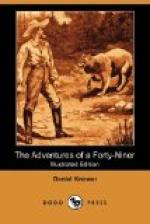I awoke the next morning refreshed. After my breakfast I took in the place and went to the raceway where the first piece of gold was discovered. There were three or four stores in the place to supply the miners of the surrounding region. I got my direction how to find the Dutch Bar, eight miles from there. Proceeding on my way, after going about five miles, I came to a person, his face covered with a long beard, whom I recognized, by the expression of his eyes, as a person who I knew in Albany, and who belonged to the party I was seeking. He informed me that I was within three miles of them, and he gave me plain directions how to find them. I soon came to their camp and there was a genial meeting and exchange of news. There were five in the company. They had a tent and owned a pair of mules. I joined them, as I had not come to depend on mining, as I never had been accustomed to physical labor. At first I thought it was awful hard work, and that it was lucky for me that I had not come to California depending on it, but after a short time I got used to it and liked it. They took turns in cooking, so each one had one day in the week that he did the cooking. We lived on fried pork and flapjacks made from wheat flour fried in the fat of the pork, tin cups for our tea and coffee, and tin dishes. We each had stone seats, and a big one in the center for our table. At night we slept under our tent. The gold rivers were not navigable. They were sunk way down deep in the earth. When the rainy season sets in during the winter months, and sometimes rains every day in the month, causing the snow to melt on the Sierra Nevada mountains, where these streams take their rise, will cause the water to rise often from ten to twenty feet in a night, and in the course of ages has worn their depth down into the earth, and is supposed to have washed out of the earth the scales of gold that are found on the banks of the rivers. The first mining was a very simple process. A party of three could work together to the best advantage. A virgin bar was where the river had once run over and now receded from it. Three persons worked together, one to clear off the sand on the ground to within six inches of the hardpan. The top earth was not considered worth washing, the scales of gold, being heavier, had settled through it, but could not penetrate that portion of the earth called the hardpan, so the earth within six inches of it was impregnated with more or less gold, and one to carry the bucket to the rocker, and the other to run the rocker, which was located close to the water. The rocker was a trough about three feet in length with three slats in it and a sieve at the upper end, on which the bucket of earth was thrown. The man worked the rocker with one hand and dipped the water out of the river with a tin-handled dipper. As he worked the rocker the fine earth and scales of gold passed through the holes of the sieve and settled behind the slats in the trough, and the stones and large lumps in which there was no gold were caught in the sieve and thrown away. After a certain number of buckets of earth had been run through in that way, the settlings behind the slats in the trough were put in a milk-pan and the water was allowed to run in the pan and the fine earth and sand would float on the top of the water. You would let that run off.




